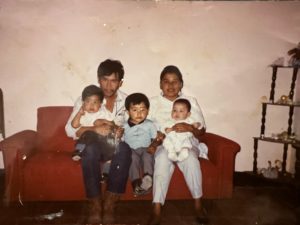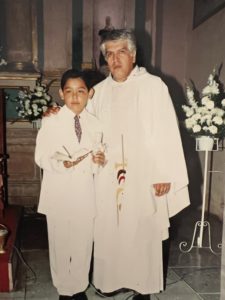Protopresbyter Joseph Dzagoev, a priest in the Protection monastery in Magadan, tells about the spiritual life in his city. He talks about well-worn stereotypes, “ordinary” Christian miracles, and how we should never get tired of trusting the Lord.
 Trinity Cathedral in Magadan
Trinity Cathedral in Magadan
The Russian antimension
Before 1989, our city was lacking not only a monastery; we didn’t have a single church. Before the Bolshevik persecutions against religion, there were churches, chapels and veneration crosses at various neighboring villages, on the coast, and in Cossack settlements. It wasn’t till the very end of the twentieth century when the persecution of the Christian faith finally officially stopped, and with the blessing of the Bishop of Khabarovsk, the very first Orthodox community was formed here. The first services were held in a private residence. This is where the Protection Monastery was later founded. Although it’s true that our city never even had a chance to have a church, because it started its life, so to speak, as a local GULAG camp in the early 1930s. That’s why any church was out of the question. We aren’t talking about the times of the Russian Empire, when churches were everywhere, and everyone, including exiles, convicts and other prisoners, always had the opportunity to attend a church service. But on the other hand, even if we didn’t have a physical church, it doesn’t mean that we had no Christians here. We have every reason to call both 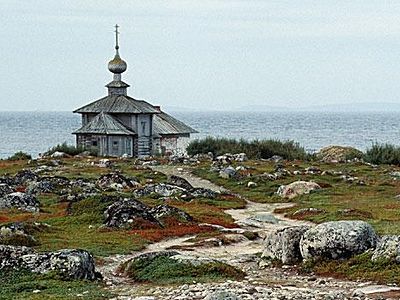 Mystical SolovkiWe have chosen for this photogallery on the feast of the Synaxis of Solovki Saints a selection from works by photographers and artists featured on the Solovki Monastery’s website.
Mystical SolovkiWe have chosen for this photogallery on the feast of the Synaxis of Solovki Saints a selection from works by photographers and artists featured on the Solovki Monastery’s website.
“>Solovki and Magadan and their surrounding territories an enormous Russian antimension spread under the open sky. How many 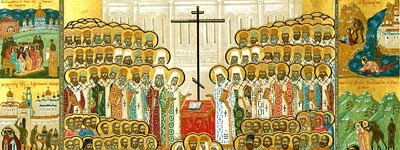 New Martyrs and Confessors of Russia“>new martyrs and confessors suffered here in very recent times!
New Martyrs and Confessors of Russia“>new martyrs and confessors suffered here in very recent times!
One of the most revered local saints is the 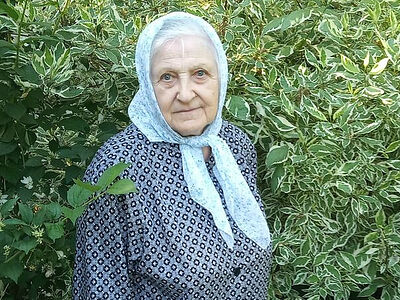 “We Saw Elders”Fr. Vitaly foretold monasticism for me and my sister forty years before we adopted it.
“We Saw Elders”Fr. Vitaly foretold monasticism for me and my sister forty years before we adopted it.
“>Venerable Confessor Andronik (Lukash), one of the elders of 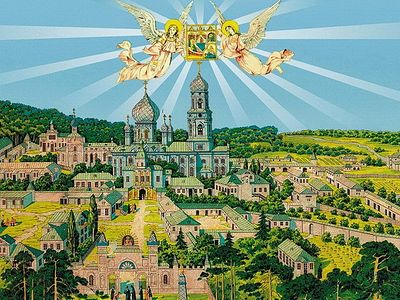 “Everything in Glinsk Exudes Holiness”The Glinsk Hermitage was a provincial monastery at the beginning of the twentieth century, located in a desert wilderness, but its glory extended not only throughout the entire Russian Empire, but even far beyond its borders.”>Glinsk Hermitage, whose relics rest in our Holy Trinity Cathedral. But there are many more saints like him—both those we know, and those known only to God. So, the place you stand is holy ground. I think we should know more about the holiness of this land.
“Everything in Glinsk Exudes Holiness”The Glinsk Hermitage was a provincial monastery at the beginning of the twentieth century, located in a desert wilderness, but its glory extended not only throughout the entire Russian Empire, but even far beyond its borders.”>Glinsk Hermitage, whose relics rest in our Holy Trinity Cathedral. But there are many more saints like him—both those we know, and those known only to God. So, the place you stand is holy ground. I think we should know more about the holiness of this land.
Well-worn stereotypes
—Fr. Joseph, how can we understand the salvific value of sufferings? How do we benefit from them if viewed from the Christian perspective? After all, not everyone who suffered here at Kolyma suffered for Christ’s sake. If we read the works of Varlam Shalamov1—it gives you jitters and you even can grow despondent.
—I have to say right away that neither I, nor many of the inhabitants of our region, are fans of Varlam Tikhonovich’s literary work. You can’t find a glimpse of light in his writing. Besides, the locals say that not everything that he wrote is truthful. But let’s leave Shalamov in peace, God rest his soul. As for the meaning and nature of suffering, in my opinion, there were prisoners (and there are still some—I have been conducting prison pastoral care since 1998 in our region, so I can talk to the prisoners) who truly suffered for the truth, for Christ’s sake, and for their loyalty to Him. But there were also some (moreover, many) who endured the hardship of imprisonment because, as many of them admit, they have been beneficial to them. They redeem from “other” sins for which they probably haven’t been “officially” convicted. These people tell me: “It’s better that I suffer here and now instead of later, in the afterlife.” I think this speaks of the humility cultivated in them. I used to meet real Christians behind bars, so we shouldn’t suppose that Kolyma is only for hardened thugs. But cultivating suffering—no, I will not do that. Let’s remember the words of the Apostle Peter: But let none of you suffer as a murderer, or as a thief, or as an evildoer, or as a busybody in other men’s matters (1 Peter 4:15).
But overall I, and the overwhelming majority of residents of Kolyma region, have already gotten quite tired of this reference, the stereotype regarding our land—that Magadan is all about the prisons, camps, tough guys in padded jackets with an inmate number, barbed wire, and so forth. It still works somehow as a gimmick for tourists, but our land has so much more and it can surprise in a good way by bring joy to someone “from the mainland.” Actually, have you noticed that we even say, “from the mainland”, despite the fact that Magadan is actually also a mainland city, while Yakutsk is only 2000 kilometers away from us?
—Aha, right, “just” a mere couple of thousand kilometers—no big deal!
—But it is so beautiful, isn’t it?
 The embankment
The embankment
—That’s true. The sea knolls, the sea, your сhurches, the embankment, the central streets and museums—it’s a pleasure to walk around!
We don’t live in the dull past, nor do we relish the allure of prison life—we have other things to do, and something and someone to pray about
—So, we don’t live in the dreary past, nor do we relish the allure of prison life—we have other things to do and something and someone to pray about. We have much to do, and that’s good. Because you can’t, after all, rush around the country “seeking greener pastures”. It is better to get comfortable in your own clean, spacious, well stocked and hospitable home. But you’ll obtain this home only when you, and not some “fairy-tale do-gooder,” take care of it yourself. Besides, that “fairy-tale do-gooder” actually does offer support; we receive sizable support from the federal budget. And no, it’s not our thing to sit here whining and waiting for better times, unwilling to lift a finger to make those better times come.
The fruits of a recent sermon and “birth pangs” of the Apostle Paul
But let us return to the idea of the Russian antimension spread under the open sky. It seems to me that the whole of Russia can serve as such antimension, since persecutions happened all over Russia. So many churches and monasteries were destroyed! I think, we, the Christians of today, can’t come even close to Holy Russia of that time.
 In the Protection monastery —And in qualitative terms?
In the Protection monastery —And in qualitative terms?
—On the one hand, I can dwell on the problems like an old man—where our young generation (including priests) is heading, that they are the victims of the “upbringing” of the 1990s, that the former generations were “warriors, far better than you,”2 “unlike the current crop of youth,” and to some extent I would probably be right. On the other hand, as a modern-day priest, I see something joyful happening before my own eyes—I wouldn’t’ say holy, I should be careful here—but examples that speak of a worthy and often miraculous Christian life.
Let’s take our Protection Monastery, for example. As I already said, it was founded around a house of worship with the blessing of Bishop Gabriel of Khabarovsk as far back as 1992. There was a community there already, but they were able to obtain their own building, albeit a small and remote one, only in the 1990s. Vladyka used to visit us here several times a year, and this community grew larger over time. Later the Magadan diocese was formed, so when Vladyka Arkady came here together with the monks, they began to travel all over Kolyma as missionaries, visiting every village and hamlet, baptizing, serving, and having conversations. That’s how the life of the Church has gradually settled here. Much later, our monastery was built, and it currently has four elderly nuns headed by Matushka Nadezhda, the abbess.
—It turns out that everyone has different gifts. One person is man of prayer, another is a master craftsman, and yet another one is an excellent organizer.
To be a follower of Christ was always considered in our fallen world to be a sort of disease—we are not right in the head if we are Christians
—I think the most difficult thing is to have only just begun the spiritual life—considering those “birth pangs” of the Apostle Paul. But later on, there comes a moment of great joy when you see that your community is growing in Christ. Thanks to Bishop Arkady’s labors, we were able to accomplish very much Above all, he succeeded in changing the attitude of the regional and city authorities towards the Church. And not just of the authorities, but also of our local people. Formerly, believers were called “relics of the past” and “pariahs,” despicable and worthless people with “issues,” who were crazy in the head. Now, largely thanks to missionary work, people have realized that first of all, Christ is risen, and secondly, His Resurrection directly affects each and every one of us. Do you choose to languish in the darkness of eternal complaints and death? Wouldn’t it be better to be joyful and work alongside Christ and His disciples? That’s where our choice is. It is, of course, a serious question—to what extent we sinners are worthy disciples of the Lord. But our failures don’t give us the right to forsake God, right? Judging from my own experience, I know how perplexed people were when we witnessed the faith. I remember how in the 1990s, when I was still working at a mining plant (I am a mine foreman by education), there was a lot of theft. And when someone made me an offer to “steal” at work, I replied that I was a Christian and I would not steal. They stared at me and kept looking at me for a long time as if I were insane. However, at any time, to follow Christ was always seen by the fallen world as a disease—we are not right in the head if we are Christians. God willing, may we be that kind of crazy.
Kolyma paradoxes and the miracles of Magadan
 Protopresbyter Joseph Dzagoev with the patients of residential care facility —The irony is that the site of the present-day Holy Trinity Cathedral in Magadan formerly housed the 1st administrative office of Dalstroy, the very consortium that brought workers, or rather slaves, to the GULAG. Later on, they decided to build the House of Soviets there, a huge one by local standards, around fourteen stories tall. But they never finished it; the structure cracked and it was impossible to commission it. That unfinished construction site has seen it all: drunken brawls, the stench of beer, teenagers committing suicide… It was horrible. But now it is the site of our magnificent Trinity Cathedral.
Protopresbyter Joseph Dzagoev with the patients of residential care facility —The irony is that the site of the present-day Holy Trinity Cathedral in Magadan formerly housed the 1st administrative office of Dalstroy, the very consortium that brought workers, or rather slaves, to the GULAG. Later on, they decided to build the House of Soviets there, a huge one by local standards, around fourteen stories tall. But they never finished it; the structure cracked and it was impossible to commission it. That unfinished construction site has seen it all: drunken brawls, the stench of beer, teenagers committing suicide… It was horrible. But now it is the site of our magnificent Trinity Cathedral.
—Wouldn’t it be wonderful if our hearts were also transformed?
—That is harder to achieve, of course. Especially now, when the war is going on, and when our boys return after witnessing all that death. What are we to do with them? God willing, some of them will find their way to the church, But what about the rest? After the Great Patriotic War, career military people were sent to work here—straight from active duty in the army, they became the camp guards. They say there was an unheard level of drunkenness here… I don’t know what will happen now. We pray that we can overcome the ordeal that befell our military men and their families.
Yes, and more about the sick. Our monastery is on good and friendly terms with the staff at the psychoneurological residential care facility. Many patients and their staff come to us, and we also visit them. We hold services, we meet and talk to people, comforting them to the best of our abilities. Here is what I want to say: According to information from the residential facility’s staff, the vast majority of their patients (and it’s something like ninety percent!) are the children of drug addicts and alcoholics. And there are about four hundred people residing there! This is the sad part.
“This Auntie taught me to read,” he says and points to the icon of the Mother of God
Now about the miracles so common for Christians. Have you noticed one young man at the service—a kind and caring one, who is smiling and willing to help everyone? This is our Sasha, and he also resides there. He came a long time ago, when the Protection Monastery had just been founded. Well, he sort of came, but he couldn’t say a word—he could only mumble something unintelligibly. Well, he kept mumbling something while we prayed together with him. All churches and communities have such people, so it’s not surprising. But one day we came to the morning service and saw our Sasha standing in front of the icon of the Mother of God, clearly reciting, “Rejoice O Virgin Mother of God.” Not only was he reciting it, but so eloquently that any pious church reader would be jealous! We stood there in amazement. Once he finished praying, we came closer. “Sasha, dearest, how did you learn to read, how do you know the words?” He answered so calmly but matter-of-factly: “This Auntie taught me!” and pointed to the icon of the Mother of God. We could only stand there in silence and continue praying. And that’s what we do! As for Sasha, he continues to come, almost never missing a service. He also helps around the monastery and assists at our meetings in his residential care facility.

So, we do have miracles, we can’t do without them. On the one hand, those miracles are truly our great support on our path to God. On the other hand, they give us a wonderful opportunity to pause and think that Christ does not work miracles without reason or purpose—any real miracle has its own meaning, and we always see God’s love in it. We also have to work hard, even if we are spiritual invalids. We can still progress towards Heaven. If we ourselves don’t make an effort, of course there won’t be miracles! So I wish for us all to keeping working. And one more thing: If you ever happen to be in Kolyma, you are cordially invited to visit us!

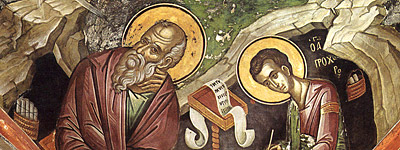 St. John the Theologian
St. John the Theologian
 Mystical SolovkiWe have chosen for this photogallery on the feast of the Synaxis of Solovki Saints a selection from works by photographers and artists featured on the Solovki Monastery’s website.
Mystical SolovkiWe have chosen for this photogallery on the feast of the Synaxis of Solovki Saints a selection from works by photographers and artists featured on the Solovki Monastery’s website. New Martyrs and Confessors of Russia“>new martyrs and confessors suffered here in very recent times!
New Martyrs and Confessors of Russia“>new martyrs and confessors suffered here in very recent times!  “We Saw Elders”Fr. Vitaly foretold monasticism for me and my sister forty years before we adopted it.
“We Saw Elders”Fr. Vitaly foretold monasticism for me and my sister forty years before we adopted it. “Everything in Glinsk Exudes Holiness”The Glinsk Hermitage was a provincial monastery at the beginning of the twentieth century, located in a desert wilderness, but its glory extended not only throughout the entire Russian Empire, but even far beyond its borders.”>Glinsk Hermitage, whose relics rest in our Holy Trinity Cathedral. But there are many more saints like him—both those we know, and those known only to God. So, the place you stand is holy ground. I think we should know more about the holiness of this land.
“Everything in Glinsk Exudes Holiness”The Glinsk Hermitage was a provincial monastery at the beginning of the twentieth century, located in a desert wilderness, but its glory extended not only throughout the entire Russian Empire, but even far beyond its borders.”>Glinsk Hermitage, whose relics rest in our Holy Trinity Cathedral. But there are many more saints like him—both those we know, and those known only to God. So, the place you stand is holy ground. I think we should know more about the holiness of this land. 





 Relics of future saint Elder Petroniu (Tănase) exhumed on Mt. AthosFr. Petroniu, who spent the last 33 years of his life on Mt. Athos, and the last 25 as abbot of Prodromu until his repose on February 22, 2011, has been proposed for canonization by the Romanian Metropolis of Muntenia and Dobrogei.”>Elder (Petroniu Tănase), Romanian Athonite elders of the 20th century,
Relics of future saint Elder Petroniu (Tănase) exhumed on Mt. AthosFr. Petroniu, who spent the last 33 years of his life on Mt. Athos, and the last 25 as abbot of Prodromu until his repose on February 22, 2011, has been proposed for canonization by the Romanian Metropolis of Muntenia and Dobrogei.”>Elder (Petroniu Tănase), Romanian Athonite elders of the 20th century,  20th-century Romanian Athonites and 18th-century hierarch proposed for canonizationThe Synod of the Romanian Orthodox Church Metropolis of Muntenia and Dobrogei has discussed the proposed canonizations of a number of saints lately.”>in 2022.
20th-century Romanian Athonites and 18th-century hierarch proposed for canonizationThe Synod of the Romanian Orthodox Church Metropolis of Muntenia and Dobrogei has discussed the proposed canonizations of a number of saints lately.”>in 2022.  Romanian diocese proposes 18th-century abbot for canonizationThe Synod of the Metropolis of Oltenia of the Romanian Orthodox Church held a session on Bright Tuesday, May 7, during which it proposed a new monastic saint for canonization.
Romanian diocese proposes 18th-century abbot for canonizationThe Synod of the Metropolis of Oltenia of the Romanian Orthodox Church held a session on Bright Tuesday, May 7, during which it proposed a new monastic saint for canonization.